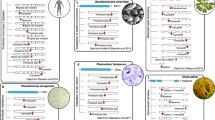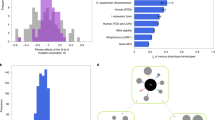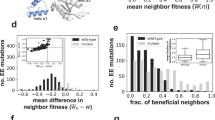Key Points
-
The distribution of fitness effects (DFE) is a fundamental entity in genetics that describes what proportion of new mutations are advantageous, neutral or deleterious.
-
The shape of the DFE varies between species and depends on factors such as population size and genome size.
-
The DFE differs between coding and non-coding DNA.
-
Advantageous mutations are rare.
-
The DFE of strongly advantageous mutations has an exponential distribution.
-
The DFE of deleterious mutations is a complex, multi-modal distribution.
Abstract
The distribution of fitness effects (DFE) of new mutations is a fundamental entity in genetics that has implications ranging from the genetic basis of complex disease to the stability of the molecular clock. It has been studied by two different approaches: mutation accumulation and mutagenesis experiments, and the analysis of DNA sequence data. The proportion of mutations that are advantageous, effectively neutral and deleterious varies between species, and the DFE differs between coding and non-coding DNA. Despite these differences between species and genomic regions, some general principles have emerged: advantageous mutations are rare, and those that are strongly selected are exponentially distributed; and the DFE of deleterious mutations is complex and multi-modal.
This is a preview of subscription content, access via your institution
Access options
Subscribe to this journal
Receive 12 print issues and online access
$189.00 per year
only $15.75 per issue
Buy this article
- Purchase on Springer Link
- Instant access to full article PDF
Prices may be subject to local taxes which are calculated during checkout




Similar content being viewed by others
References
Crow, J. F. How much do we know about spontaneous human mutation rates? Environ. Mol. Mutagen. 21, 122–129 (1993).
Kondrashov, A. S. & Crow, J. F. A molecular approach to estimating the human deleterious mutation rate. Hum. Mutat. 2, 229–234 (1993).
Ohta, T. The nearly neutral theory of molecular evolution. Annu. Rev. Ecol. Syst. 23, 263–286 (1992).
Loewe, L. Quantifying the genomic decay paradox due to Muller's ratchet in human mitochondrial DNA. Genet. Res. 87, 133–159 (2006).
Charlesworth, D., Charlesworth, B. & Morgan, M. T. The pattern of neutral molecular variation under the background selection model. Genetics 141, 1619–1632 (1995).
Peck, J. R., Barreau, G. & Heath, S. C. Imperfect genes, Fisherian mutation and the evolution of sex. Genetics 145, 1171–1199 (1997).
Caballero, A. & Keightley, P. D. A pleiotropic nonadditive model of variation in quantitative traits. Genetics 138, 883–900 (1994).
Zhang, X. S. & Hill, W. G. Genetic variability under mutation selection balance. Trends Ecol. Evol. 20, 468–470 (2005).
Eyre-Walker, A., Woolfit, M. & Phelps, T. The distribution of fitness effects of new deleterious amino acid mutations in humans. Genetics 173, 891–900 (2006).
Schultz, S. T. & Lynch, M. Mutation and extinction: the role of variable mutational effects, synergistic epistasis, beneficial mutations and degree of outcrossing. Evolution 51, 1363–1371 (1997).
Reich, D. E. & Lander, E. S. On the allelic spectrum of human disease. Trends Genet. 17, 502–510 (2001).
Johnson, T. & Barton, N. H. Theoretical models of selection and mutation on quantitative traits. Philos. Trans. R. Soc. Lond. B Biol. Sci. 360, 1411–1425 (2005).
Burch, C. L., Guyader, C., Samarov, D. & Shen, H. Experimental estimate of the abundance and effects of nearly neutral mutations in the RNA virus φ6. Genetics 176, 467–476 (2007).
Elena, S. F., Ekunwe, L., Hajela, N., Oden, S. A. & Lenski, R. E. Distribution of fitness effects caused by random insertion mutations in Escherichia coli. Genetica 102–103, 349–358 (1998).
Sanjuan, R., Moya, A. & Elena, S. F. The distribution of fitness effects caused by single-nucleotide substitutions in an RNA virus. Proc. Natl Acad. Sci. USA 101, 8396–8401 (2004). Estimates the DFE for an RNA virus by measuring the fitness consequences of single mutations.
Thatcher, J. W., Shaw, J. M. & Dickinson, W. J. Marginal fitness contributions of nonessential genes in yeast. Proc. Natl Acad. Sci. USA 95, 253–257 (1998).
Wloch, D. M., Szafraniec, K., Borts, R. H. & Korona, R. Direct estimate of the mutation rate and the distribution of fitness effects in the yeast Saccharomyces cerevisiae. Genetics 159, 441–452 (2001).
Mukai, T. The genetic structure of natural populations of Drosophila melanogaster. I. Spontaneous mutation rate of polygenes controlling viability. Genetics 50, 1–19 (1964). The first mutation accumulation experiment.
Ohnishi, O. Spontaneous and ethyl methanesulfate-induced mutations controlling viability in Drosophila melanogaster. II. Homozygous effect of polygenic mutations. Genetics 87, 529–545 (1977).
Bataillon, T. Estimation of spontaneous genome-wide mutation rate parameters: whither beneficial mutations? Heredity 84, 497–501 (2000).
Joseph, S. B. & Hall, D. W. Spontaneous mutations in diploid Saccharomyces cerevisiae: more beneficial than expected. Genetics 168, 1817–1825 (2004).
Shaw, F. H., Geyer, C. J. & Shaw, R. G. A comprehensive model of mutations affecting fitness and inferences for Arabidopsis thaliana. Evolution 56, 453–463 (2002).
Bateman, A. J. The viability of near-normal irradiated chromosomes. Int. J. Radiat. Biol. 1, 170–180 (1959).
Garcia-Dorado, A. The rate and effects distribution of viable mutation in Drosophila: minimum distance estimation. Evolution 51, 1130–1139 (1997).
Keightley, P. D. The distribution of mutation effects on viability in Drosophila melanogaster. Genetics 138, 1315–1322 (1994).
Keightley, P. D. Inference of genome wide mutation rates and distributions of mutations effects for fitness traits: a simulation study. Genetics 150, 1283–1293 (1998).
Davies, E. K., Peters, A. D. & Keightley, P. D. High frequency of cryptic deleterious mutations in Caenorhabditis elegans. Science 285, 1748–1751 (1999). Shows that most mutations are undectable in a mutation accumulation study and that the DFE of deleterious mutations must be complex and multi-modal.
Denver, D. R., Morris, K., Lynch, M. & Thomas, W. K. High mutation rate and predominance of insertions in the Caenorhabditis elegans nuclear genome. Nature 430, 679–682 (2004).
Eyre-Walker, A., Keightley, P. D., Smith, N. G. C. & Gaffney, D. Quantifying the slightly deleterious model of molecular evolution. Mol. Biol. Evol. 19, 2142–2149 (2002).
Loewe, L. & Charlesworth, B. Inferring the distribution of mutational effects on fitness in Drosophila. Biol. Lett. 2, 426–430 (2006).
Loewe, L., Charlesworth, B., Bartolome, C. & Noel, V. Estimating selection on nonsynonymous mutations. Genetics 172, 1079–1092 (2006).
Nielsen, R. & Yang, Z. Estimating the distribution of selection coefficients from phylogenetic data with applications to mitochondrial and viral DNA. Mol. Biol. Evol. 20, 1231–1239 (2003).
Piganeau, G. & Eyre-Walker, A. Estimating the distribution of fitness effects from DNA sequence data: implications for the molecular clock. Proc. Natl Acad. Sci. USA 100, 10335–10340 (2003).
Sawyer, S., Kulathinal, R. J., Bustamante, C. D. & Hartl, D. L. Bayesian analysis suggests that most amino acid replacements in Drosophila are driven by positive selection. J. Mol. Evol. 57, S154–S164 (2003).
Bustamante, C. D., Wakeley, J., Sawyer, S. & Hartl, D. L. Directional selection and the site-frequency spectrum. Genetics 159, 1779–1788 (2001).
Bubb, K. L. et al. Scan of human genome reveals no new loci under ancient balancing selection. Genetics 173, 2165–2177 (2006).
Kimura, M. Genetic variability maintained in a finite population due to the mutational production of neutral and nearly neutral isoalleles. Genet. Res. 11, 247–269 (1968).
Johnson, K. P. & Seger, J. Elevated rates of nonsynonymous substitution in island birds. Mol. Biol. Evol. 18, 874–881 (2001).
Woolfit, M. & Bromham, L. Population size and molecular evolution on islands. Proc. Biol. Sci. 272, 2277–2282 (2005).
Silander, O. K., Tenaillon, O. & Chao, L. Understanding the evolutionary fate of finite populations: the dynamics of mutational effects. PLoS Biol. 5, e94 (2007). Shows that the DFE is highly dependent on the fitness of the population that is being considered.
Lynch, M. & Conery, J. S. The origins of genome complexity. Science 302, 1401–1404 (2003).
Subramanian, S. & Kumar, S. Higher intensity of purifying selection on >90% of the human genes revealed by the intrinsic replacement mutation rates. Mol. Biol. Evol. 23, 2283–2287 (2006).
Eyre-Walker, A. Changing effective population size and the McDonald–Kreitman test. Genetics 162, 2017–2024 (2002).
Charlesworth, J. & Eyre-Walker, A. The rate of adaptive evolution in enteric bacteria. Mol. Biol. Evol. 23, 1348–1356 (2006).
Orgel, L. E. & Crick, F. H. C. Selfish DNA: the ultimate parasite. Nature 284, 604–607 (1980).
Cliften, P. et al. Finding functional features in Saccharomyces genomes by phylogenetic footprinting. Science 301, 71–76 (2003).
Shabalina, S. A. & Kondrashov, A. S. Pattern of selective constraint in C. elegans and C. briggsae genomes. Genet. Res. 74, 23–30 (1999).
Webb, C. T., Shabalina, S. A., Ogurtsov, A. Y. & Kondrashov, A. S. Analysis of similarity within 142 pairs of orthologous intergenic regions of Caenorhabditis elegans and Caenorhabditis briggsae. Nucleic. Acids Res. 30, 1233–1239 (2002).
Andolfatto, P. Adaptive evolution of non-coding DNA in Drosophila. Nature 437, 1149–1152 (2005). Provided the first evidence that adaptive evolution is widespread in Drosophila non-coding DNA.
Bergman, C. M. & Kreitman, M. Analysis of conserved noncoding DNA in Drosophila reveals similar constraints in intergenic and intronic sequences. Genome Res. 11, 1335–1345 (2001). Provided the first indication that extensive amounts of Drosophila non-coding DNA is subject to selection.
Halligan, D. L. & Keightley, P. D. Ubiquitous selective constraints in the Drosophila genome revealed by a genome-wide interspecies comparison. Genome Res. 16, 875–884 (2006).
Dermitzakis, E. T. et al. Numerous potentially functional but non-genic conserved sequences on human chromosome 21. Nature 420, 578–582 (2002). Provided the clearest evidence that substantial amounts of mammalian non-coding DNA is subject to selective constraint.
Koop, B. F. Human and rodent DNA sequence comparisons: a mosaic model of genomic evolution. Trends Genet. 11, 367–371 (1995).
Shabalina, S. A., Ogurtsov, A. Y., Kondrashov, V. A. & Kondrashov, A. S. Selective constraint in intergenic regions of human and mouse genomes. Trends Genet. 17, 373–376 (2001).
Mouse Genome Sequencing Consortium. Initial sequencing and comparative analysis of the mouse genome. Nature 420, 520–562 (2002).
Dermitzakis, E. T., Reymond, A. & Antonarakis, S. E. Conserved non-genic sequences — an unexpected feature of mammalian genomes. Nature Rev. Genet. 6, 151–157 (2005).
Gaffney, D. & Keightley, P. D. Genomic selective constraints in murid noncoding DNA. PLoS Genet. 2, e204 (2006).
Eyre-Walker, A. The genomic rate of adaptive evolution. Trends Ecol. Evol. 21, 569–575 (2006).
Chimpanzee Sequencing and Analysis Consortium. Initial sequence of the chimpanzee genome and comparison with the human genome. Nature 437, 69–87 (2005).
Zhang, L. & Li, W.-H. Human SNPs reveal no evidence of frequent positive selection. Mol. Biol. Evol. 22, 2504–2507 (2005).
Bierne, N. & Eyre-Walker, A. Genomic rate of adaptive amino acid substitution in Drosophila. Mol. Biol. Evol. 21, 1350–1360 (2004).
Smith, N. G. C. & Eyre-Walker, A. Adaptive protein evolution in Drosophila. Nature 415, 1022–1024 (2002).
Welch, J. J. Estimating the genome-wide rate of adaptive protein evolution in Drosophila. Genetics 173, 821–837 (2006).
Bachtrog, D. & Andolfatto, P. Selection, recombination and demographic history in Drosophila miranda. Genetics 174, 2045–2059 (2006).
Williamson, S. H. Adaptation in the env gene of HIV-1 and evolutionary theories of disease progression. Mol. Biol. Evol. 20, 1318–1325 (2003).
Keightley, P. D., Lercher, M. J. & Eyre-Walker, A. Evidence for widespread degradation of gene control regions in hominid genomes. PLoS Biol. 3, e42 (2005).
Gillespie, J. H. Molecular evolution over the mutational landscape. Evolution 38, 1116–1129 (1984).
Orr, H. A. The distribution of fitness effects among beneficial mutations. Genetics 163, 1519–1526 (2003). An extension of the work of Gillespie showing that the DFE of advantageous mutations should be an exponential distribution under certain simplifying assumptions.
Imhof, M. & Schlotterer, C. Fitness effects of advantageous mutations in evolving Escherichia coli populations. Proc. Natl Acad. Sci. USA 98, 1113–1117 (2001).
Kassen, R. & Bataillon, T. Distribution of fitness effects among beneficial mutations before selection in experimental populations of bacteria. Nature Genet. 38, 484–488 (2006).
Rokyta, D. R., Joyce, P., Caudle, S. B. & Wichman, H. A. An empirical test of the mutational landscape model of adaptation using a single-stranded DNA virus. Nature Genet. 37, 441–444 (2005).
Cowperthwaite, M. C., Bull, J. J. & Meyers, L. A. Distributions of beneficial fitness effects in RNA. Genetics 170, 1449–1457 (2005). Provided evidence that the DFE of advantageous mutations is not an exponential distribution.
Bratteler, M., Lexer, C. & Widmer, A. Genetic architecture of traits associated with serpentine adaptation of Silene vulgaris. J. Evol. Biol. 19, 1149–1156 (2006).
Lexer, C., Rosenthal, D. M., Raymond, O., Donovan, L. A. & Rieseberg, L. H. Genetics of species differences in the wild annual sunflowers, Helianthus annuus and H. petiolaris. Genetics 169, 2225–2239 (2005).
Schemske, D. W. & Bradshaw, H. D. Jr. Pollinator preference and the evolution of floral traits in monkeyflowers (Mimulus). Proc. Natl Acad. Sci. USA 96, 11910–11915 (1999).
Mukai, T., Chigusa, S. I., Mettler, L. E. & Crow, J. F. Mutation rate and dominance of genes affecting viability in Drosophila melanogaster. Genetics 2, 333–355 (1972).
Vassilieva, L., Hook, A. M. & Lynch, M. The fitness effects of spontaneous mutations in Caenorhabditis elegans. Evolution 54, 1234–1246 (2000).
Elena, S. F. & Moya, A. Rate of deleterious mutation and the distribution of its effects on fitness in vesicular stomatitis virus. J. Evol. Biol. 12, 1078–1088 (1999).
Zeyl, C. & DeVisser, J. A. Estimates of the rate and distribution of fitness effects of spontaneous mutation in Saccharomyces cerevisiae. Genetics 157, 53–61 (2001).
Avila, V. et al. Increase of the spontaneous mutation rate in a long-term experiment with Drosophila melanogaster. Genetics 173, 267–277 (2006).
Garcia-Dorado, A., Monedero, J. L. & Lopez-Fanjul, C. The mutation rate and the distribution of mutational effects of viability and fitness in Drosophila melanogaster. Genetica 102–103, 255–256 (1998).
Keightley, P. D. Nature of deleterious mutation load in Drosophila. Genetics 144, 1993–1999 (1996).
Schoen, D. J. Deleterious mutation in related species of the plant genus Amsinckia with contrasting mating systems. Evolution 59, 2370–2377 (2005).
Garcia-Dorado, A. & Caballero, A. On the average coefficient of dominance of deleterious spontaneous mutations. Genetics 155, 1991–2001 (2000).
Peters, A. D., Halligan, D. L., Whitlock, M. C. & Keightley, P. D. Dominance and overdominance of mildly deleterious induced mutations for fitness traits in Caenorhabditis elegans. Genetics 165, 589–599 (2003).
Shaw, R. G. & Chang, S. M. Gene action of new mutations in Arabidopsis thaliana. Genetics 172, 1855–1865 (2006).
Williamson, S. H. et al. Simultaneous inference of selection and population growth from patterns of variation in the human genome. Proc. Natl Acad. Sci. USA 102, 7882–7887 (2005).
Li, W.-H., Tanimura, M. & Sharp, P. M. An evaluation of the molecular clock hypothesis using mammalian DNA sequences. J. Mol. Evol. 25, 330–342 (1987).
Ohta, T. Synonymous and nonsynonymous substitutions in mammalian genes and the nearly neutral theory. J. Mol. Evol. 40, 56–63 (1995).
Bush, E. C. & Lahn, B. T. Selective constraint on noncoding regions of hominid genomes. PLoS Comput. Biol. 1, e73 (2005).
Keightley, P. D., Kryukov, G. V., Sunyaev, S., Halligan, D. L. & Gaffney, D. J. Evolutionary constraints in conserved nongenic sequences of mammals. Genome Res. 15, 1373–1378 (2005).
Kryukov, G. V., Schmidt, S. & Sunyaev, S. Small fitness effect of mutations in highly conserved non-coding regions. Hum. Mol. Genet. 14, 2221–2229 (2005).
Lynch, M. et al. Spontaneous deleterious mutation. Evolution 53, 645–663 (1999).
Acknowledgements
We thank M. Whitlock, S. Otto, A. Betancourt and four anonymous referees for many helpful comments on the manuscript. A.E.W. was supported by the Biotechnology and Biological Sciences Research Council (BBSRC) and the National Evolutionary Synthesis Center. P.K. was supported by the Wellcome Trust and the BBSRC.
Author information
Authors and Affiliations
Corresponding author
Ethics declarations
Competing interests
The authors declare no competing financial interests.
Related links
Glossary
- Muller's ratchet
-
The process by which a genome with little or no recombination degenerates owing to the stochastic loss of the allelic class with fewest deleterious mutations.
- Kurtosis
-
The peakedness of the distribution.
- Effective population size
-
The population size of randomly mating individuals that would behave, in a population genetic sense, as the population being studied. For example, the genetic diversity in human populations is the same as one would find in 10,000 randomly mating individuals.
- Leptokurtic
-
Used here to refer to distributions that are more peaked than an exponential distribution.
- Multi-modal
-
A distribution with more than one peak or mode.
Rights and permissions
About this article
Cite this article
Eyre-Walker, A., Keightley, P. The distribution of fitness effects of new mutations. Nat Rev Genet 8, 610–618 (2007). https://doi.org/10.1038/nrg2146
Issue Date:
DOI: https://doi.org/10.1038/nrg2146
This article is cited by
-
Targeted accurate RNA consensus sequencing (tARC-seq) reveals mechanisms of replication error affecting SARS-CoV-2 divergence
Nature Microbiology (2024)
-
Genetic and demographic consequences of range contraction patterns during biological annihilation
Scientific Reports (2023)
-
Evolvability-enhancing mutations in the fitness landscapes of an RNA and a protein
Nature Communications (2023)
-
Mutualism reduces the severity of gene disruptions in predictable ways across microbial communities
The ISME Journal (2023)
-
Intrahost evolution of the gut microbiota
Nature Reviews Microbiology (2023)



